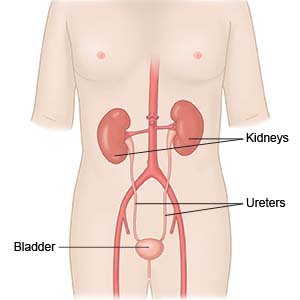Transurethral Resection of Bladder Tumors
Medically reviewed by Drugs.com. Last updated on Aug 4, 2025.
What do I need to know about a transurethral resection of bladder tumors?
Transurethral resection of bladder tumors (TURBT) is surgery to remove one or more tumors from your bladder.
 |
How do I prepare for TURBT?
- Your surgeon will talk to you about how to prepare. He or she may tell you not to eat or drink anything after midnight on the day of your surgery. Arrange to have someone drive you home from surgery.
- Tell your surgeon about all medicines you currently take. He or she will tell you if you need to stop any medicine for surgery, and when to stop. He or she will tell you which medicines to take or not take on the day of surgery.
- You may need blood or urine tests before your surgery. You may also need a CT scan or a cystoscopy. Antibiotics may be given to prevent or treat a bacterial infection.
- An IV will be put into a vein. You may be given liquids or medicine through the IV.
- General anesthesia may be given to keep you asleep and free from pain during surgery. Spinal or epidural anesthesia may instead be given to numb the area. You may still feel pressure or pushing during surgery, but you should not feel pain. Healthcare providers will talk to you about which kind of anesthesia is right for you.
Related medications
What will happen during TURBT?
Your surgeon will insert a scope through your urethra and into your bladder. He or she will put fluid through the scope to wash your bladder and widen it for surgery. The scope will have a wire with an electric current. The current is used to stop bleeding in your bladder and remove bladder tumors. Your surgeon may also remove muscle and tissue from your bladder. He or she may use the scope to insert medicine into your bladder. The medicine will destroy pieces of tumor in your bladder and help prevent new tumors from growing.
What should I expect after TURBT?
You will be taken to a room to rest until you are fully awake. You will be monitored closely for any problems. Do not get out of bed until your healthcare provider says it is okay. You will then be able to go home or be taken to your hospital room.
- A Foley catheter is a tube put into your bladder to drain urine into a bag. Keep the bag below your waist. This will prevent urine from flowing back into your bladder and causing an infection or other problems. Also, keep the tube free of kinks so the urine will drain properly. Do not pull on the catheter. This can cause pain and bleeding, and may cause the catheter to come out.
- Medicines may be given to relieve or treat pain or nausea. Antibiotics may be given to prevent a bacterial infection.
What are the risks of TURBT?
You may bleed more than expected or get an infection. Your bladder may be damaged. It may be painful to urinate, or you may have blood in your urine. You may feel discomfort in your abdomen or pelvis. You may feel like you need to urinate more often or without warning. You may develop more bladder tumors.
Care Agreement
You have the right to help plan your care. Learn about your health condition and how it may be treated. Discuss treatment options with your healthcare providers to decide what care you want to receive. You always have the right to refuse treatment. The above information is an educational aid only. It is not intended as medical advice for individual conditions or treatments. Talk to your doctor, nurse or pharmacist before following any medical regimen to see if it is safe and effective for you.© Copyright Merative 2025 Information is for End User's use only and may not be sold, redistributed or otherwise used for commercial purposes.
Further information
Always consult your healthcare provider to ensure the information displayed on this page applies to your personal circumstances.
